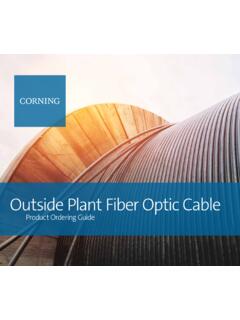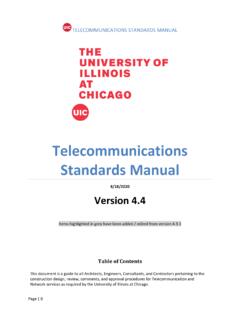Transcription of Fiber to the home (FTTH) architecture overview
1 FTTH architecture white paper series Fiber to the home (FTTH) architecture overview A centralized approach typically uses a 1x32 splitter located in a Fiber distribution hub (FDH). The hub may be located anywhere in the network. The 1x32 splitter is directly connected via a single Fiber Not all FTTH networks are built the same. to an GPON optical line terminal (OLT) in the central office. On the Since construction and outside plant account other side of the splitter, 32 fibers are routed through distribution for the majority of total network costs, getting panels, splice ports and/or access point connectors to 32 customers'. the architecture right has a major impact on homes, where it is connected to an optical network terminal (ONT).
2 Thus, the PON network connects one OLT port to 32 ONTs. the business case. The network architecture can also impact time-to-market, labor/training Centralized requirements, future upgradeability, network 1. 2. performance, and ultimately customer satisfaction. Central office 1x32. splitter 3.. to customer 32. Fiber distribution hub This paper provides an overview of two fundamental FTTH. architecture categories centralized and cascaded that determines Cascaded 1. where in the network the Fiber is split. Splitter placement and split 1x8 2. ratios strongly impact the location and amount of Fiber required, and splitter .. to customer hence the cost of deployment.
3 This is followed by a brief discussion 8. of several designs. This work draws upon over a decade of 9. 1x8 10. experience that CommScope has in helping service providers around splitter 1 .. the world design, build, and maintain FTTH networks, including 2 16. Central 1x4. variations such as FTTN, FTTC and FTTB networks. office splitter 3. 17. 4. 18. 1x8. This overview paper is the first in CommScope's FTTH architecture splitter .. Series. Papers in this series discuss different architectures, along 24. with their benefits, trade-offs and disadvantages, providing an 25. 1x8 26. objective look at each architecture to help service providers make splitter.
4 Informed decisions. 32. stage 1 splitter stage 2 splitter Centralized or cascaded? Or, how many splitter stages? Figure 1: Comparison of centralized and cascaded architectures The Passive Optical Network (PON) is the optical Fiber infrastructure of an FTTH network. The first crucial architectural decision for the A cascaded approach may use a 1x4 splitter residing in an outside PON network is that of optical splitter placement. The centralized plant enclosure. This is directly connected to an OLT port in the approach uses single-stage splitters located in a central hub in a star central fice. Each of the four fibers leaving this stage 1 splitter is topology.
5 The cascaded approach uses multi-stage splitters in a routed to an access terminal that houses a 1x8, stage 2 splitter. In tree-and-branch topology. this scenario, there would be a total of 32 fibers (4x8) reaching FTTH architecure overview 1. 32 homes. It is possible to have more than two splitting stages in a hardened multifiber optical connectors (HMFOCs) for easily cascaded system, and the overall split ratio may vary (1x16 = 4 x 4, connecting 12- Fiber OSP cables in the distribution network. Both the 1x32 = 4 x 8, 1x64 = 4 x 4 x 4). FDH and terminal tails can be connectorized to just plug together, providing a more fully connectorized architecture .
6 A centralized architecture typically offers greater flexibility, lower operational costs and easier access for technicians. A cascaded A fully-connectorized centralized approach using an FDH offers approach may yield a faster return-on-investment, lower firstin some attractive benefits: speed of deployment; maximum long-term costs and lower Fiber costs. When deciding on the best approach, flexibility; and future-proofing aspects. Maximizing the use of it's important to understand these architectures in detail and connectors instead of splices whenever it makes sense also enhances weigh the trade-offs. Let's look at some examples that illustrate the accessibility of the network.
7 One ideal area for a centralized the similarities and differences. approach is where take rates are not guaranteed, but may increase steadily as the area is further developed over time. Centralized using closures In this architecture , the feeder cable from the central office is connected to a closure at the Fiber distribution point of the network. The closure performs as the splitter housing. However, while an FDH. leverages connectorization as much as possible, the closure system is typically spliced together. Still, the closure remains accessible for adding splitters at a later time, so it's possible to deploy the network for an expected take rate and add splitters if the take rate increases.
8 Additional closures can be deployed downstream from the main closure to further extend the network. Figure 2: Fiber Distribution Hub Centralized using Fiber Distribution Hubs (FDH). This architecture centers on the FDH where every end user or building in the neighborhood is represented. It makes very efficient use of the splitters, maximizes accessibility, provides easier troubleshooting and accelerates turn-ups/ reconfigurations. The architecture typically begins with a 1x32 splitter placed inside Figure 3: Drops at stage 2 splitter the FDH, with the 32 split fibers routed through distribution panels, splice ports, and/or access point connectors to the ONTs The architecture begins with the feeder cable running from the at 32 homes.
9 A series of terminals make up the distribution side central office to the closure, where it is spliced to the splitters inside. of the FDH. These terminals may be integrated into the network The splitter outputs then extend out to a few splice closures. This using splices, connectors or a combination. architecture is designed for very small distribution areas, so there are typically only a few splice closures and a relatively small splitter While spliced terminals offer great flexibility in how a network can count. The distribution fibers are spliced into drop cable splice be installed and the lowest optical loss, they require much higher closures, such as the hybrid connector-splice closures, and drop labor costs and additional time for deployment.
10 Almost every cables are spliced in for connecting the ONTs at each home. network will employ some combination of splices and connectors, where they make the most sense. Since the centralized with closures architecture is typically spliced together, equipment costs are minimized. But lower initial costs may For connectorized options, hardened connectors add some be offset as time goes on by reduced flexibility and higher significant benefits. These are specifically designed for use harsh maintenance costs. Still, the architecture is ideally suited for very environmental conditions and will speed up deployments while small distribution areas, such as one requiring only two closures off reducing labor/installation costs.





